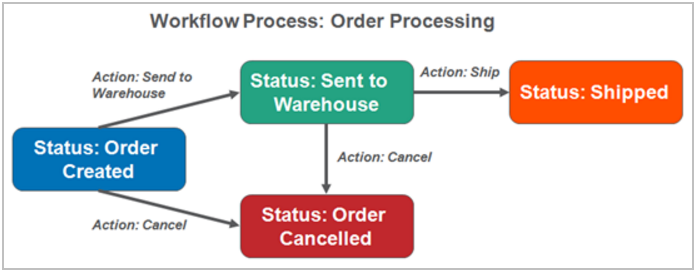Low-code application development platforms like Progress Rollbase provide the services you need to get your app up and running, grow faster and keep up with your own success.
In our previous blog post, What is a Low-code Platform, we saw that one key characteristic of a low-code platform is the rich set of built-in services the platform provides. We didn’t have time to get into any details there, but in this post, we will explore the value these services provide.
Developing without a Low-code Platform
Imagine you have a great idea, you spend a couple of months developing an initial web application; you deploy and are starting to get some usages. You build a few more features and usage picks up. You have a nascent successful application.
Soon, however, some clouds appear. New requirements come in faster than you can process them, these requirements require integration knowledge your team does not have and competition is breathing down your neck. You have a hard time hiring the needed expertise. You put up a plan to create a roadmap and prioritize all the requirements. You start on some of the highest priority items but soon realize this is going to take more time than anyone had estimated. You announce a delay for the next release date and right after that you discover security and scalability issues in the initial design. You have to go back to the drawing board.
Now your delivery speed has come to a crawl and you do not know how you will be able to compete. If you had used a low-code platform you would already be releasing your 3rd or 4th major release.
In this blog post, we will explore how a high-value/low-code platform like Rollbase alleviates or even eliminates many of the issues mentioned in our very real example above.
At a very high level, Rollbase solves these issues by:
- Providing an all encompassing multi-application development, deployment and management environment.
- Offering a lot of point and click services that address the needs of typical modern multi-device web applications that need to scale and act reliably, so that you can focus your programming efforts on solving your business problems.
Sounds too good to be true? Well, read on (this is a long post, I apologize in advance but it is a testament to how rich the platform is).
Application Platform Services
Rollbase:
- Allows for the creation of web applications using point-and-click/drag-and-drop tools and metadata model methodology. Applications can be extended and customized with code at specific hook points.
- Offers a variety of very rich sets of backend and front-end services.
- Provides the ability to deploy, run, scale and manage the application both in various cloud platforms as well as on premise.
Let’s explore the rich set of back end and front end services.
As we saw in my earlier blog post explaining low-code platforms, we get an object model for objects and their relationships (1 to 1, 1 to n, n to m); for example, Travel Destination object and its associated Hotels and Flights, or a portfolio and its associated stocks and bonds (1 to n relationship). What that means is that as soon as we define these objects, we get a dynamically generated application for these objects and their relationships working across multiple devices (smartphones, tablets and desktops) without writing a single line of code and without any need for specialists in responsive and adaptive UIs.
We also automatically get REST APIs to access these objects. We get search and indexing: application data gets automatically indexed for built-in search capabilities. We can Import and Export data to various formats like Excel, .csv and .pdf.
But that’s just the tip of the iceberg. You also immediately get access to built-in high value services. Please, read on for a more detailed list.
Data Integration
Connecting to existing data sources is probably one of the first things that will slow you down. Your users will need access to existing data spread across many databases—particularly with enterprise applications. Rollbase, with simple configurations, can connect to existing data sources, define an object model and auto generate a multi-device UI.
Additionally, all this data will now be available for any of the additional built-in features like, for example, custom reporting or document generation, compounding the benefits of a low-code platform.
Email and Calendar Integration
Like data integration, email integration is one of the first requirements that will consume your precious development resources. Some of the key built-in features you get for free:
- Email capabilities: Integration with various providers like Exchange or Google.
- Email templates: Create email templates to tailor email content with application data.
- Email triggers: Send emails automatically upon any condition, for example, when someone rates a hotel at 2 or less. Or when a specific workflow status has been reached (emails and workflow are key pillars to build many enterprise applications quickly and efficiently).
Rollbase includes a full-fledged calendar widget that lets you create meetings and other events, and to track tasks and their flows. The calendar component in this case synchronizes with the Exchange account. So any meetings you add in Rollbase can be seen on your Exchange calendar as well.
Workflow
Workflow capabilities are central to many applications. For example, you want to create a ticketing system where the ticket gets through various states like created, open, fixed, tested and closed.
Or you need to implement a workflow process for handling orders as in the following diagram:

Combining workflow and roles allows you to control who can actually perform or authorize some operations. This can be achieved with just point and click configurations.
Security, Permissions and Roles
You get, out of the box, a Security Model (Authentication/Authorization) and Roles: you do not have to worry about designing, implementing and most importantly testing your own security model.
Specifically, the Roles and Permissions system allows you to grant access to various operations and fields with simple configurations (no-coding). Now, for more advanced cases, you can even turn auditing on to track when and who does what to various objects with just a configuration option.
The key point is that you do not need to re-invent, code and test an access mechanism.
But it does not stop there. You also get:
- User management: Creating and provisioning users.
- Authentication: Login, logout and password maintenance (change password and forgot password features).
- Multiple authentication providers out of the box:
- SAML
- ADFS
- OpenID Connect
- LDAP
- Kerberos
- Encryption: with a single click, you can make a field encrypted so that its content is protected at rest.
- Whitelisting IP addresses.
Auditing
Implementing your own Security and Roles Model would be a hugely time consuming task. The same is true with auditing. The platform provides, with a few configuration clicks, the capability to enforce that an audit record be created for specific actions. For example, when users create, delete or modify a record or when they take specific action in a workflow process like approving a loan.
File Management and Cloud Storage
You can create objects with the document attribute. You get out of box without any coding:
- File attachments management and upload widget.
- File size limits enforcement.
- Built-in search: Attached files in standard Word, Excel, PDF or plain text formats can be indexed for full text search.
- Ability to configure Amazon S3 as storage location
Writing Reports—Generating Documents
As soon as you have a rich data set, various stakeholders will want access to dynamically generated reports. Creating your own solution is time consuming and connecting to third party reporting tool is expensive. With a low-code platform like Rollbase, you get built-in tools to create custom reports on demand.
The same is true for generating documents. Your users will soon want to generate Word or PDF files with data from your various objects. The last thing you want to spend your precious development time is on licensing the proper libraries and learning APIs to create a word or PDF file. Rollbase provides out of the box document generation with document Templates.
UI Services
- Multiple-device support from smartphones, tablets to desktop.
- Charts: Show charts without coding.
- Smart images: The ability by the platform to automatically serve images with the most optimized size based on device rendering ability, and the ability to for the application administrator to restrict images to a maximum size independently of the size of the images uploaded by your user base.
- Geographical map: Get a map in your UI with a simple click to show where a travel destination is located.
- Events and tasks as well as a built-in Calendar view (all with support for the standard iCalendar format). For example, to make appointments for customers of the portfolio application.
- Built-in PDF annotations.
- I18N:
- Support for several built-in translated languages as well as support for multi-lingual interface: You can immediately tackle international market.
- Support for RTL text direction (Arabic, Farsi and Hebrew languages).
- UI Appearance:
- Built-in themes—Custom themes support.
- Multiple UI blueprints—Custom blueprints.
API Access
Sooner or later someone else will want to integrate with your successful application. With Rollbase, as soon as you create an object model, you get access to it via REST and SOAP. Again, saving you precious time to market and development resources.
Deployment and Run Related
The benefits of a low-code platform are not limited to application development. The last thing you want to do when your application starts to have success in the market is slow your delivery time because you cannot scale and maintain high availability. When it comes to deploying, scaling and running a solution, Rollbase provides numerous invaluable services such as:
- Scalability: As you become successful you can allocate more resources without any coding.
- High availability: Some application use cases require high availability and automatic failover capabilities. Again, a low-code platform such as Rollbase provides these services so that you don’t have to worry about coding high availability.
- Configuring platform usage consumption.
- Backup.
- Scheduled jobs.
- Monitoring.
Cloud Related
- Multi-tenant management: You can quickly scale your applications to multiple customers without the associated cost of maintaining multiple environments while preserving total isolation. This is particularly useful when you have a large number of small customers.
- Marketplace: The platform provides a store from which your users can install applications, and where you can easily publish them.
Try and Fail Fast, then Accelerate
In conclusion, using a low-code platform like Rollbase allows you to build and deploy web applications for multiple devices at an unprecedented speed and at a drastically reduced cost (try and fail fast)—and then to accelerate your delivery speed dramatically when your application becomes successful. You don’t have to code lots of services and you don’t have to go through the long process of acquiring knowledge and hiring expertise in specific domains.
Additionally, as many features are configuration options, they can be configured at runtime by an application administrator, avoiding round-trips with development and thus providing even more flexibility than ever before.
You can learn more about how Rollbase can help you quickly build low-code applications here.
Editor's note: This post was originally published in September 2016, and was thoroughly updated in May 2017 for accuracy and completeness.

Thierry Ciot
Thierry Ciot is a Software Architect on the Corticon Business Rule Management System. Ciot has gained broad experience in the development of products ranging from development tools to production monitoring systems. He is now focusing on bringing Business Rule Management to Javascript and in particular to the serverless world where Corticon will shine. He holds two patents in the memory management space.

